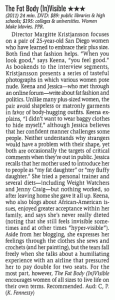Praise
Marilyn Wann, fat activist and author of Fat!So?: Because You Don’t Have to Apologize For Your Size, raved: “[The Fat Body (In)visible] offers much-needed visibility for proud fat people who resist weight-based oppression and is a great resource for starting discussions about weight diversity with people of all sizes. A smart, good-looking, nuanced film.”
Author Harriet Brown (Brave Girl Eating: A Family’s Struggle With Anorexia) said “The Fat Body (In)Visible is a compelling look at the world of fat acceptance and what it’s like to be a fat woman in America today.”
Bill Fabrey, founder of the National Association to Advance Fat Acceptance, called the film “long overdue!”
Lesley Kinzel, freelance writer and fat activism blogger, declared it “…necessary, beautiful, smart, thoughtful, vivid…”
And bitchmagazine.org’s review of the documentary said “[the two protagonists] share their experiences of people judging their mere existence just because they’re fat, becoming empowered through fashion, the intersection of race and fatness, and finding community.”
Reviews
“Kristjansson’s film provides an engaging optic on issues of fat pride and visibility. The two subjects are compelling, dynamic women with much to say about fat fashion, style and blogging. The Fat Body (in)visible illuminates the contradictions of fat women, rendered both inappreciable and transparent by widespread fat panic.” – Kathleen LeBesco, PhD and author, Revolting Bodies? The Struggle to Redefine Fat Identity.
“The Fat Body (In)Visible is a short and deceptively simple documentary. On its surface, it features two young, fat women, Jessica and Keena, who discuss their experiences with fatness, marginalization, and bodily reclamation. Underlying their discussions is a consideration of the politics of fat visibility in a thin-centric world. Fat bodies are constructed as too much flesh, not enough willpower, excessively nourished, unsatisfactorily healthy, hypersexual, asexual. As such, fatness is both hypervisible, a spectacle, and invisible, ignored. By what means can fat persons reclaim their right to appear in public, to take up space, to be? The Fat Body (In)Visible addresses the radical possibilities of appearing, both literally in fashion and metaphorically through online communities, in public spaces. Only twenty-four minutes long, this documentary invokes provocative questions about the political possibilities of fat activists reclaiming the right to make fat bodies visible on their own terms.” – Lesleigh Owen, Instructor of Sociology at Chaffey College
“Margitte Kristjansson’s remarkable documentary is a minor miracle of feminist, body-positive activism for the early 21st century. Focused on the personal experiences of two fat women in San Diego–one white, one black–the documentary catalogues the routine (and often openly hostile) encounters with prejudice and the shaming,body-phobic culture that fat people are forced to endure daily. Kristjansson’s triumph, however, is demonstrating the degree to which these fat women resist these hostile encounters through individual and collective action–on-line communities and discussion groups, fat fashion shows, and interrogations with strangers in public space–affirm their commitment to cultural activism not despite their status as fat women (and women of color) but because of their status asfat women. This documentary would be useful for undergraduate and graduate courses (especially curricula focused in women’s studies, feminist/gender studies, queer studies, disability studies), as well as short-subject film festivals, public libraries, LGBT community centers, and activist groups focused on raising awareness about social oppression and forging new models of social and political resistance.” – David Serlin, Associate Professor and Chair, Department of Communication at UCSD
